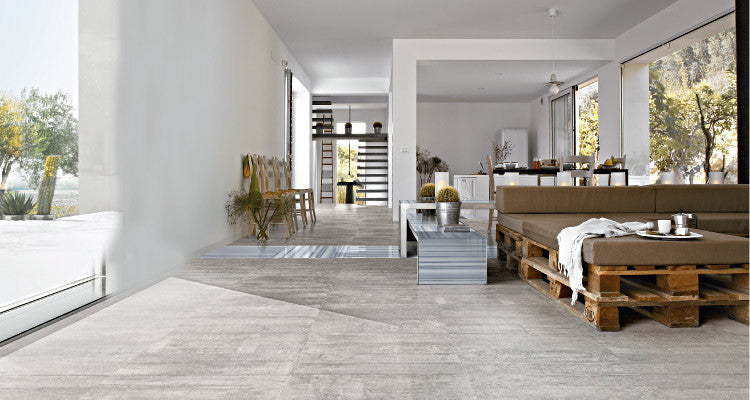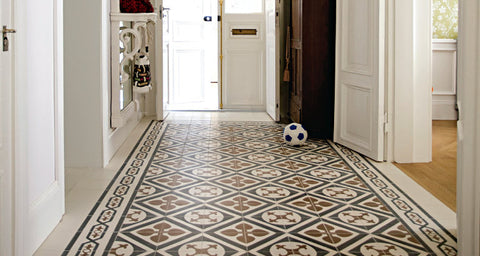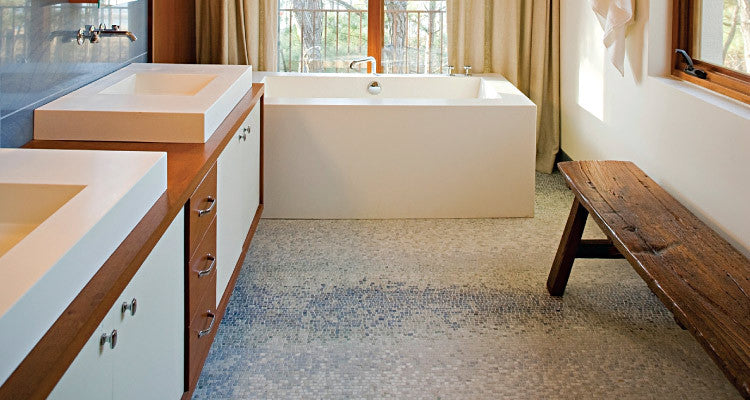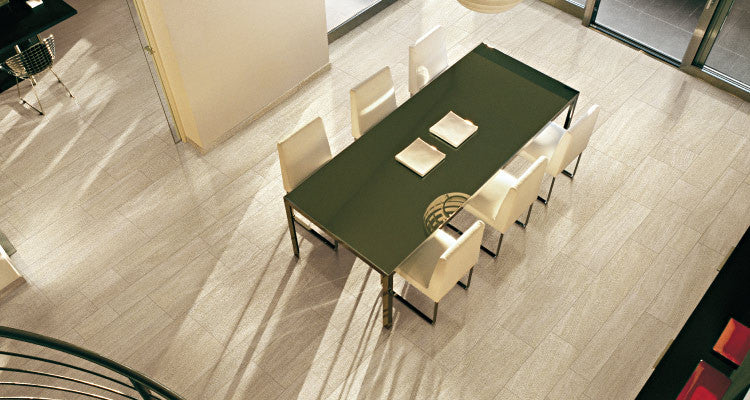Atlanta Home Improvement Magazine
Posted by William Buyok on
In light of the current real-estate market, Americans are staying in their homes longer than in the recent past. Longer stays have lead to an increase in personalization, with the home serving as a vehicle for self-expression. Those daring to build again and those looking for a fun remodel will find inspiration in the artistic qualities of decorative cement tile as well as custom installations of porcelain, marble, limestone and natural stone tile. From subtle to bold, indoor to outdoor and modern to traditional, the options for statement-making floors are endless.
Stylish cement
While decorative cement tile has long been an art form, it is becoming more mainstream thanks to manufacturers offering new, contemporary looks as well as homeowners seeking design elements that reflect their personal tastes. Melanie Stephens, co-founder and director of design and marketing for Granada Tile, www.granadatile.com, often meets clients and designers looking for handmade, organic and custom options. “There is no formula for success because tiles are so personalized with each homeowner,” she says.
This may explain why the decorative cement tile product range is so diverse today, ranging from classic Spanish and Moroccan motifs to modern geometric patterns—all in an array of colors. You can even create your own design: “There is a company out of Michigan, Betona, that sells flexible concrete tile,” says Jonathan Embrose, of Specialty Tile Products, www.specialtytileproducts.com. “They can customize the tile to look like anything, from photographs to Disney illustrations.”
The more forgiving and flexible nature of a new manufacturing process means cement tiles can now be used for outdoor installations as well as indoors. “Tiles that look like pavers can be used in freeze-and-thaw locations with the addition of binders in the concrete,” says Bill Buyok, owner of Avente Tile, www.aventetile.com. Some tiles also are rated for vehicular traffic and allow for increased customization and limitless color and design combinations.
Ron Williamson, director of marketing services at Ironrock, www.ironrock.com, says tile can be used in a lot of creative ways, especially in outdoor spaces such as bench seating, grill islands, pools and water features. Owners also are finding clever ways to “add a design sense to otherwise utilitarian areas like laundry rooms,” he says. “Tile can pull from the best of the past or be completely innovative.”
While indoor tiles often are used as backsplashes, flooring and wall coverings, Stephens has seen more ambitious clients use tile on an entire floor area, inside shower stalls or continue tiles from the floor to the walls and ceilings. Some homeowners, she says, keep existing wood floors while tiling surrounding walls for spectacular effects. “Tiling walls in bathrooms has become very popular as well as interior and exterior walls for design drama,” says Leslie Dean, manager at Daltile’s Atlanta Tile & Stone Gallery, www.daltile.com.


Twisted tradition
Although decorative cement tile is creating a buzz, natural stone tile and other more traditional materials continue to find favor with homeowners. “Marble and limestone are very popular stone choices for kitchens and bathrooms,” says Dean. She says porcelain is another go-to because it requires less maintenance than natural stone.
However, even the most common tile materials are being used in new ways to mix things up. Dean says she is seeing more rectangle and arabesque shapes as well as beveled edges and linear and vein cuts. Buyok concurs, saying: “You’ll find all the square formats of the traditional style plus rectangles, clipped corners, octagons, hexagons, pickets, sextant and arabesque shapes.”
Another trend that puts a new spin on a traditional material is porcelain tile that looks like hardwood flooring, says Elisabeth Stubbs, owner of Enhance Floors & More, www.enhancefloors.com. These tiles are being used mostly in areas prone to moisture, she says, offering homeowners the look of hardwood without the associated risk of water or moisture damage.
Homeowners seeking a one-of-a-kind look also can opt for custom installation to dress up floors. There are about 40 different ways to install tile in any given room such as brick, diagonal and hopscotch patterns, Stubbs says, adding that larger spaces work better because the design is more apparent. Another way to customize a tile floor? “Contrast between tile and grout colors really shows off a custom install,” Stubbs says.
Updating a floor or wall with stock or custom tiles can change a space dramatically. Those interested in a more traditional or subtle look should go back to earthy colors and static patterns with solids and borders interacting well. Simple, united designs with well-placed accents, classic shapes and random shade variations yield the most success in traditional spaces.



Expert advice
When opting for a tile floor, keep in mind that tiles are an almost permanent floor covering. For instance, “if using a strong color, you’re married to this color,” Stubbs says. This factor also makes labor and installation an important consideration. “Don’t skimp on labor because there’s only one way to fix a bad installation and that’s with a sledgehammer. There’s no easy way to fix it.”
First, make sure to clarify whether the price is “per tile” or “per square foot.” This can make a big difference in the total price of the tile. “There is a wide range in price and quality,” Stubbs says of tile products. In her experience, she says most people can find something they like between $2 and $3 per square foot, not including installation and labor.
However, many decorative cement tiles range from $5 to $10 per square foot, are made to order and require up to eight weeks lead time. When evaluating decorative cement tile, choose a quality and respected manufacturer and a vendor familiar with concrete because “cement tiles are not made to any ‘recognized standard’ and won’t be labeled with a PEI rating like you’ll find on manufactured ceramic tiles,” says Buyok.
Stephens also suggests carefully considering the weight and height of decorative cement tiles before installation. “Each tile weighs three pounds. Check with an architect or engineer to make sure your subfloor is strong enough,” she says.
When removing old flooring, owners should calculate the difference in height between the old floor and the cement tile for best results.
When it comes to installation, the appropriate underlayment and setting materials should be applied in a clean environment free of debris that could prevent proper adhesion. After fully set, the area should be washed with lightly soaped water in favor of acidic cleaning agents. Then, a high-quality, penetrating sealer should be applied, testing first on a small portion of tile.
To keep tile floors looking their best, proper care and maintenance is essential. Maintenance for most tiles is relatively simple: Use a mild detergent or cleaner that is not abrasive. Think Mr. Clean instead of Soft Scrub. “Harsh cleaners should never be put on tiles, as this can take off the original luster,” Dean says.
For decorative cement tile floors, routine cleaning is done by sweeping away debris before washing with a mix of water and industry-specified wax. Beware that accidental drops can create unsightly and hard-to-repair breaks. And, while sealed cement products are stain-resistant, accidents not cleaned immediately can wear away both sealant and color.
Share this post
- Tags: Print
